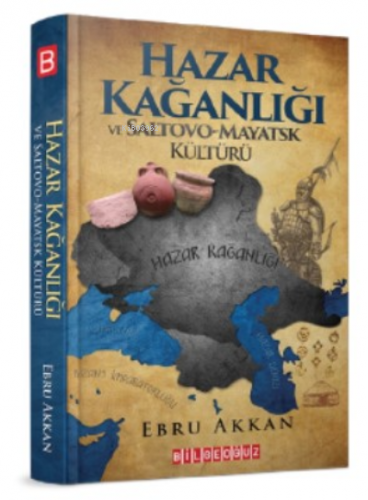9786256359192
595103

https://www.sehadetkitap.com/urun/hazar-kaganligi-ve-saltovo-mayatsk-kulturu
Hazar Kağanlığı Ve Saltovo - Mayatsk Kültürü
250.00
VII. yüzyıldan itibaren Doğu Avrupa'da askeri ve politik hakimiyet kuran Hazar Kağanlığı'nın
oluşturduğu gelişmiş devlet sistemi, güvenlik ağı ve hoşgörü ortamı zengin bir kültür yarattı. Bu kültüre
Hazar Kağanlığı nüfusuna ait ilk arkeolojik bulguların ortaya çıkarıldığı günümüz Ukrayna Saltov ve
Rusya Federasyonu sınırları içindeki Mayatsk antik yerleşimine istinaden “Saltovo-Mayatsk Kültürü” adı
verildi. Göktürk İmparatorluğu'nun batı uzantısı olarak ortaya çıkan Hazar Kağanlığı nüfusuna ait bu
kültürün arkeolojik bulguları onun Doğu Avrupa ve Kazakistan bozkırlarından Sibirya ve Altaylar ötesine
uzanan kadim Türk kültürünün izlerini taşıdığını gösteriyor. Bu kitap sadece Hazar Kağanlığına ait
Saltovo-Mayatsk kültürünü tanıtmakla kalmıyor bu kültürü yaratan nüfusun antropolojik özelliklerini ve
onun kadim Türkistan coğrafyası ile bağlantılarını bilimsel verilerle açıklamaya çalışıyor ve Doğu
Avrupa tarihini yazılı ve arkeolojik verilere dayanarak baştan yazıyor.
The Khazar Khaganate, which emerged as the western extension of the Göktürk Empire and established
military and political dominance in Eastern Europe starting from VII. century, created a rich and
prosperous culture with its advanced state system, safety net and environment of tolerance. The first
archaeologic findings belonging to the Khazar Khaganate population were unearthed in modern-day
Ukranian Saltov settlement and in ancient Mayatsk within the borders of Russian Federation. In honor
of these first findings, The Khazar Khaganate culture was named as “Saltovo-Mayatsk”. The features of
Saltovo-Mayatsk demonstrates that it bears the traces of ancient culture of Turkish tribes extending from
East Europe through Kazakhstan steps to beyond Siberia and Altays. This book not only introduces the
Saltovo-Mayatsk culture of the Khazar Khaganate, but also tries to explain the anthropological characteristics of
the population that created this culture and its connections with the ancient Türkestan geography and rewrites
the history of Eastern Europe based on written and archaeological scientific data.
VII. yüzyıldan itibaren Doğu Avrupa'da askeri ve politik hakimiyet kuran Hazar Kağanlığı'nın
oluşturduğu gelişmiş devlet sistemi, güvenlik ağı ve hoşgörü ortamı zengin bir kültür yarattı. Bu kültüre
Hazar Kağanlığı nüfusuna ait ilk arkeolojik bulguların ortaya çıkarıldığı günümüz Ukrayna Saltov ve
Rusya Federasyonu sınırları içindeki Mayatsk antik yerleşimine istinaden “Saltovo-Mayatsk Kültürü” adı
verildi. Göktürk İmparatorluğu'nun batı uzantısı olarak ortaya çıkan Hazar Kağanlığı nüfusuna ait bu
kültürün arkeolojik bulguları onun Doğu Avrupa ve Kazakistan bozkırlarından Sibirya ve Altaylar ötesine
uzanan kadim Türk kültürünün izlerini taşıdığını gösteriyor. Bu kitap sadece Hazar Kağanlığına ait
Saltovo-Mayatsk kültürünü tanıtmakla kalmıyor bu kültürü yaratan nüfusun antropolojik özelliklerini ve
onun kadim Türkistan coğrafyası ile bağlantılarını bilimsel verilerle açıklamaya çalışıyor ve Doğu
Avrupa tarihini yazılı ve arkeolojik verilere dayanarak baştan yazıyor.
The Khazar Khaganate, which emerged as the western extension of the Göktürk Empire and established
military and political dominance in Eastern Europe starting from VII. century, created a rich and
prosperous culture with its advanced state system, safety net and environment of tolerance. The first
archaeologic findings belonging to the Khazar Khaganate population were unearthed in modern-day
Ukranian Saltov settlement and in ancient Mayatsk within the borders of Russian Federation. In honor
of these first findings, The Khazar Khaganate culture was named as “Saltovo-Mayatsk”. The features of
Saltovo-Mayatsk demonstrates that it bears the traces of ancient culture of Turkish tribes extending from
East Europe through Kazakhstan steps to beyond Siberia and Altays. This book not only introduces the
Saltovo-Mayatsk culture of the Khazar Khaganate, but also tries to explain the anthropological characteristics of
the population that created this culture and its connections with the ancient Türkestan geography and rewrites
the history of Eastern Europe based on written and archaeological scientific data.
Yorum yaz
Bu kitabı henüz kimse eleştirmemiş.











